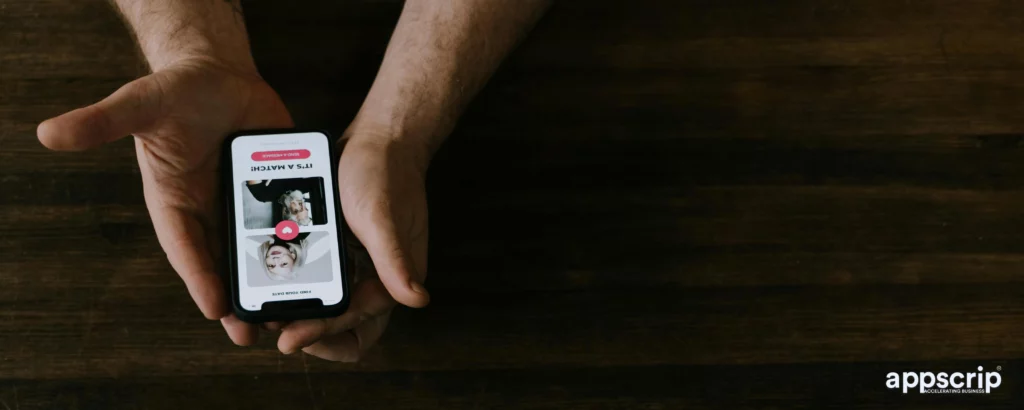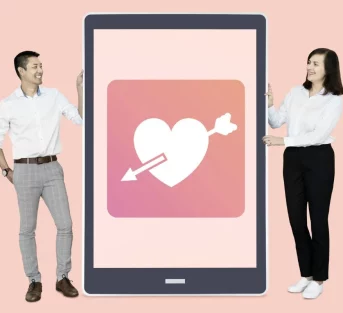Even though there are suggestions that the dating industry is passing through a dull phase, the fact remains there’s room for niche dating apps. Dating apps like Veggly – connect with vegans, Teamup – connecting fitness fanatics, Bristlr – for women who love beards, and more to name a few.
Dating platforms with their innovative algorithms are becoming adept at finding you the right match, based on your preferences, location, and shared interests. That keeps the dating app development realm alive and kicking.
In 2016, the number of users in the global dating landscape were 240.9 million, that number hit 366 million in 2022. By 2028, this number is expected to grow to 452.47 million users. Clearly signifying that people are turning to digital means to find connections.
Entrepreneurs looking to launch a dating app will find Appscrip’s dating software solution a powerful, feature-rich platform, that’s scalable and customisable. Want to know more, get in touch.
TL;DR
Despite claims of a swiping fatigue, niche dating apps are thriving. The dating industry is projected to reach 452.47 million users by 2028, signalling continued growth.
Key Considerations for Dating App Development:
- Frameworks: Native (Swift, Kotlin), Cross-Platform (React Native, Flutter), Hybrid (Ionic), or Web-Based (PWAs)
- Frontend vs. Backend
- Custom vs. Clone Apps
App Development Lifecycle:
- Idea & Research – Identify target audience and market gaps.
- Planning & Strategy – Choose tech stack, business model, and budget.
- UI/UX Design – Wireframing, prototyping, and testing.
- Development – Frontend (React Native, Swift, Kotlin) and Backend (Node.js, Django) implementation.
- Testing & QA – Security, performance, and UI/UX testing.
- Deployment & Launch – App Store submission, CI/CD integration.
- Post-Launch Growth – User analytics, updates, and monetization strategies.
Free Tools for Development:
- Firebase, PostgreSQL – Backend & database
- React Native, Flutter – Cross-platform development
- Figma, Canva – UI/UX design
- GitHub, Android Studio, Xcode – Development & version control
- Google Analytics, Mixpanel – User tracking
What is Dating App Development?
The process of creating a mobile or web application that connects people based on shared interests, location, or preferences is in the simplest terms known as dating app development.
Even though the cardinal act of finding a match has been reduced to swiping left or right in many solutions, dating apps are helping people meet, connect, and form meaningful relationships.
From matchmaking algorithms to user-friendly interfaces and profile creation to messaging, dating apps demand both technical expertise and creative thinking. While the goal is to create an app that’s secure, engaging, and scalable..

Are background checks a necessity?
Dating App Frameworks
Choosing the right framework is essential when developing a software solution, even if it’s a dating app. The framework plays a huge role in deciding how the app functions and how your customers will interact with it.
Choosing the right framework will be the deciding factor for your dating app’s success. Here are some popular options:
1. Native Development:
Used to create apps for iOS or Android. Native development provides platform specific features, enjoyable user experience, and amazing performance, but demands more time and resources.
o iOS: Swift or Objective-C.
o Android: Kotlin or Java.
2. Cross-Platform Development:
If you’re looking for a quick TAT on both iOS and Android, then frameworks like React Native or Flutter are your best bet. Developers write code just once and deploy it on both platforms.
o React Native: Cross-platform helps build efficient apps that work on both iOS and Android with a single codebase.
o Flutter: Flutter has a reputation for customizable user interface and fast performance.
3. Hybrid Development:
o Ionic: Web technologies like HTML, CSS, JavaScript are used to build apps that run on multiple platforms.
o PhoneGap: Not widely known, but is an hybrid option that isn’t as popular as Ionic.
4. Web-Based Frameworks:
Dating apps are also built as Progressive Web Apps (PWAs) so that users can access the app through a web browser. This makes the app easily accessible on different devices without a download.
Each framework has its own pros and cons. But it’s up to you to decide which one to choose depending on your budget, timeline, and app requirements.
| Framework | Strengths | Best Use Case |
| React Native | – Cross-platform development | Full-featured dating apps |
| – Large community | ||
| – Native performance | ||
| Flutter | – Fast development | Visually complex apps |
| – Rich UI capabilities | ||
| – High performance | ||
| Node.js | – Real-time features | Backend services |
| – Scalability | ||
| – Active community | ||
| Laravel | – Robust security | Complex backend systems |
| – MVC architecture |
Backend vs. Frontend Development Considerations
Frontend Development:
Frontend development takes care of how users interact with the app. It’s the front façade of the application, consisting of the design, user interface (UI), and user experience (UX). Frontend development needs to be intuitive and users should be able to easily manoeuvre around the features available.
Key considerations include:
· UI/UX Design: Focus on user-friendly designs. Use swipe functionality, easy navigation, and visually appealing profiles.
· Performance: Optimize for fast loading times and smooth animations.
· Cross-Platform Compatibility: Make sure your app looks and works great on both iOS and Android devices.
Backend Development:
Backend development is the support functionality for the frontend ensuring data storage, user authentication, and matchmaking algorithms. A good backend will entail fast performance.
Key considerations include:
- Database: Scalable databases like MongoDB, Firebase, or PostgreSQL are key to store user profiles, chats, and preferences.
- APIs: Robust APIs are vital for user registration, profile matching, real-time messaging and more.
- Security: Implement encryption, secure authentication (OAuth 2.0), and regular security audits to ensure user data is protected.
Both, the frontend and the backend need to work cohesively for a seamless app experience. While a well-designed frontend gives users an enjoyable experience, an efficient backend ensures the frontend is fast and responsive.
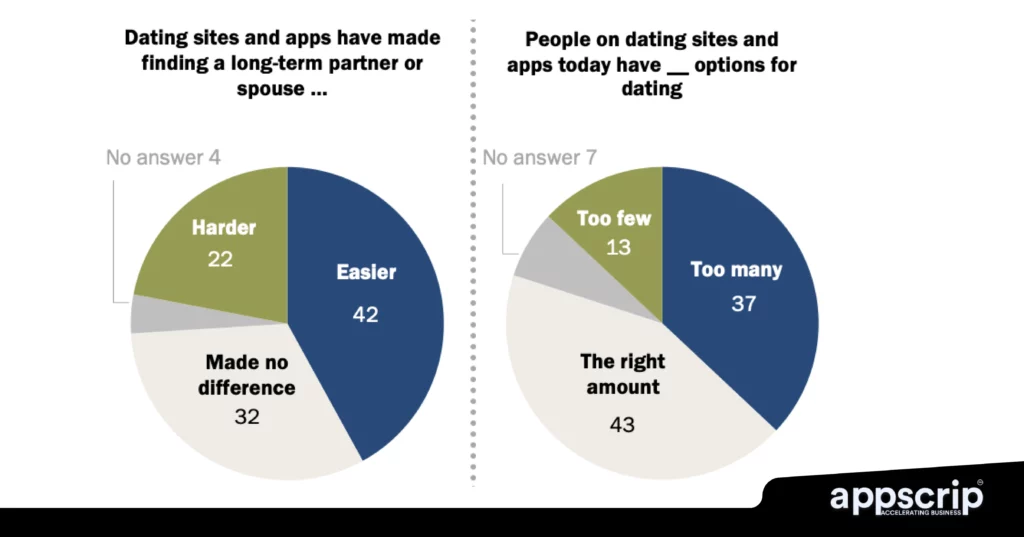
How helpful are dating apps?
Custom App vs. Clone App
With a clone app you can quickly enter the market with a proven concept at a lower cost and development time, while a custom app ensures scalability, long-term flexibility, and unique features.
| Factor | Clone App Development | Custom App Development |
| Development Time | Quick – Pre-built templates, cut go-to market time. | Longer – Requires custom development from scratch. |
| Cost | Affordable – As it repurposes existing code. | Expensive – Custom development and design increase costs. |
| Customization | Restricted – To the existing framework of the clone. | Fully Customizable – To match business needs. |
| Scalability | Not Much – Might struggle to handle large user bases. | Scalable – Designed to support future growth. |
| Security | Lower – Often lacks robust security measures. | Higher – Custom security features can be implemented. |
| Performance | Not Really – May not be fully optimized for all devices. | Smooth – Efficient performance customised to the platform. |
| Uniqueness | Generic – Could look similar to other apps. | Unique – Can have distinct branding and features. |
| Maintenance & Updates | Hard – Updates depend on the original clone framework. | Easier – Can be updated independently. |
| App Store Approval | Challenging – Due to similarity with existing apps. | Smoother – Follows platform guidelines from the start. |
| Long-term Viability | Less Sustainable – Due to limited flexibility. | Long-term – Built for continuous evolution and market changes. |
Essential Features for a Dating App
There are a plethora of features available in dating apps, but we shall list out here what truly counts and can make a difference in the acceptance of a dating app.
- Face Verification – Face verification ensures authenticity and prevents fake accounts.
- Video Profile – Increase trust and authenticity by posting videos on profiles.
- Random Video Dating – Swipe and connect with random online users via video calls (premium feature).
- Speed Dating – Hour-long speed-dating events to connect with matches over 5 minute audio calls.
- Swipe Feature – A simple, engaging way to browse through potential matches.
- Matching Algorithm – AI-powered system for suggesting compatible matches.
- Location-Based Matching – Connects users based on proximity.
- Verification & Safety Features – Using government ID for verification, profile moderation, and reporting tools to ensure safety.
- Send Gifts and Coins – To matches and prospects, along with personal notes.
- Subscription & Premium Features – Options for boosting profiles, unlimited swipes, or exclusive matches.
- Privacy Controls – Give users control over their data and visibility.
| Category | Features |
| User Profiles | – Photo uploads |
| – Bio section | |
| – Interests and preferences | |
| Matching Algorithm | – Location-based matching |
| – Swipe functionality (like/dislike) | |
| – AI-driven suggestions | |
| Communication | – Real-time messaging |
| – Video calls | |
| – Voice notes | |
| Security | – Two-factor authentication |
| – Profile verification | |
| – Report/block users | |
| Additional Features | – Push notifications |
| – In-app purchases | |
| – Social media integration |
Steps in the App Development Lifecycle
The app development lifecycle follows a structured process to ensure the product that is developed is of high-quality. Below are the key steps involved:
1. Conceptualization (Idea & Research)
- Define the target audience, app’s moto, and unique value proposition.
- Research the market and analyse the competition, various niches and industry trends.
- Identify user pain points and validate the demand.
2. Planning & Strategy
- Create a Product Requirements Document (PRD) with inputs on features, user flows, and technical details.
- Decide on a business model (e.g., subscription, freemium, ads).
- Come up with a tech stack (e.g., React Native or Flutter for mobile, Node.js for backend).
- Your budget, timeline, and development route (in-house or outsourced).
3. UI/UX Design (Wireframing & Prototyping)
- Create wireframes (sketches of app screens).
- Develop UI designs using tools (like Figma, Adobe XD, or Sketch).
- At first release an interactive prototype and collect user feedback.
- Conduct UX testing and refine the user journey.
4. Development (Coding & Implementation)
Frontend Development:
- Mobile app development Swift, Kotlin (iOS & Android) OR using React Native, Flutter.
- Web development (as per business plan) using React, Vue.js, or Angular.
Backend Development:
- Set up the server, database, APIs, and authentication using Node.js, Django, or Ruby on Rails.
- Implement real-time features (like chat, notifications) with Firebase or Socket.io.
5. Testing & QA (Quality Assurance)
- Unit Testing – Make individual functions and components work.
- Integration Testing – Check how different modules interact.
- UI/UX Testing – This is to ensure a smooth user experience.
- Performance Testing – Optimize load times and scalability.
- Security Testing – Protect against data breaches, SQL injection, and XSS attacks.
- Tools: There are several tools such as Selenium, Jest, Firebase Test Lab, Postman, Appium.
6. Deployment (Launch)
- Set up CI/CD key part of DevOps for automated deployment using GitHub Actions or Jenkins.
- Deploy the backend to AWS, Google Cloud, DigitalOcean, or Firebase.
- Publish the app on Google Play Store & Apple App Store.
- Ensure compliance with store policies.
7. Post-Launch & Maintenance
- Monitor user feedback and fix bugs using tools like Google Analytics, Firebase Crashlytics, or Sentry.
- Release regular updates (UI improvements, new features, security patches).
- Implement marketing strategies (SEO, ASO, influencer collaborations, paid ads).
- Scale the app by introducing premium features, subscriptions, or in-app purchases.
For Growth & Scaling
🔹 For the growth of the app, analysing user behaviour is vital using Mixpanel or Amplitude.
🔹 Any project hinges on monetization options to succeed, there are several ways to monetise an app, like ads, subscriptions, or partnerships.
🔹 To retain users and convert them to paid customers, expand features based on AI, blockchain, or gamification.
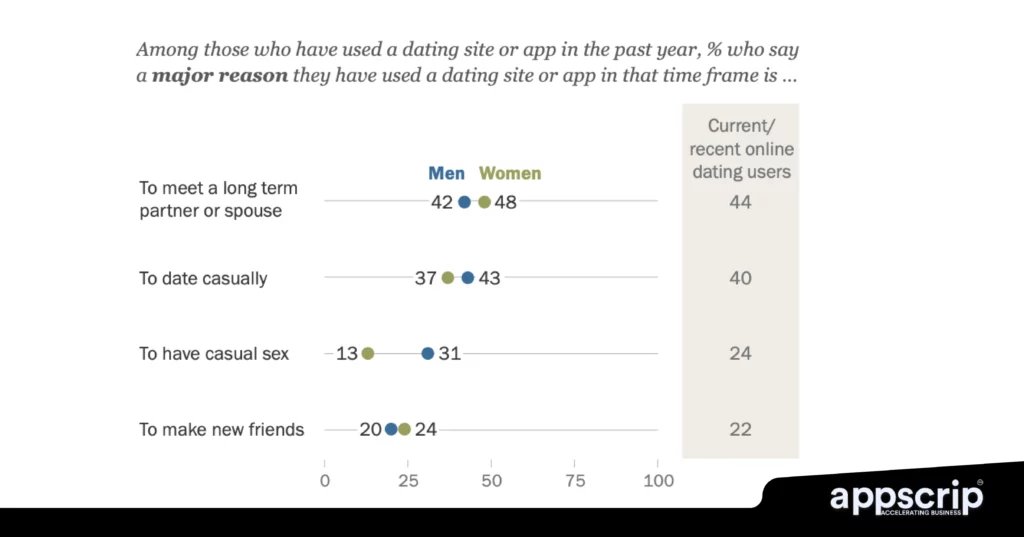
Major reasons for using dating apps.
Free Tools and Platforms for App Development
You don’t need to break the bank to get started. Here are some free tools and platforms to build your dating app:
| Tool/Platform | Purpose |
| Firebase | Backend development, real-time database, and user authentication. |
| React Native | Open-source framework for cross-platform app development. |
| Flutter | Open-source UI toolkit to build natively compiled apps for mobile, web, desktop from a single codebase. |
| Figma & Canva | Free UI/UX design tool for creating app prototypes and Wireframes. |
| GitHub | Version control and collaboration for developers. |
| Android Studio | Free IDE for Android app development. |
| Xcode | Free IDE for iOS app development. |
| PostgreSQL & MySQL | Free database solutions for storing user data. |
| Google Analytics / Mixpanel | Track user behaviour and engagement. |
| Stripe & PayPal SDKs | Free tools to integrate payment solutions. |
| OpenAI API & Google ML Kit | Enhance matching with AI-driven insights. |
Other free tools include:
1. IDEs & Code Editors (For Writing Code)
- Android Studio – Best for native Android app development (Java/Kotlin).
- Xcode – Free tool for iOS app development (Swift/Objective-C).
- Visual Studio Code – Lightweight code editor with powerful extensions.
- Eclipse – Open-source IDE for Java-based development.
2. Cross-Platform Development Frameworks
- Flutter (Google) – Uses Dart, ideal for high-performance mobile & web apps.
- React Native (Meta) – JavaScript-based, allows cross-platform development.
- Apache Cordova – Uses HTML, CSS, and JavaScript for hybrid apps.
- Swift Playgrounds – Free iPad tool for learning Swift and iOS app development.
3. Backend Development & Database (Cloud Services)
- Firebase (Free Plan) – NoSQL database, authentication, cloud functions.
- Supabase – Open-source alternative to Firebase, offers free-tier hosting.
- MongoDB Atlas (Free Tier) – NoSQL cloud database with free-tier hosting.
- PostgreSQL – Open-source relational database.
- Node.js & Express.js – Popular backend framework for APIs.
- Django (Python) & Flask (Python) – Backend frameworks for scalable apps.
4. UI/UX Design & Prototyping
- Figma – Free collaborative UI / UX design tool.
- Adobe XD (Starter Plan) – Free plan for wireframing and prototyping.
- Canva – For quick UI assets, icons, and mockups.
- InVision Freehand – Free wireframing and prototyping tool.
5. API Development & Testing
- Postman (Free Tier) – For testing APIs.
- Swagger (OpenAPI) – Helps design, document, and test APIs.
- Mocky – Free tool to create mock APIs for development.
6. App Analytics & Monitoring
- Google Analytics for Firebase – Free app analytics & crash reporting.
- AppMetrica (By Yandex) – Free mobile analytics tool.
- Sentry – Free error tracking for apps.
- Amplitude (Free Plan) – Behavioral analytics tool.
7. App Deployment & Hosting
- GitHub (Free Plan) – Version control & open-source collaboration.
- Bitbucket (Free Plan) – Git repository hosting for teams.
- Netlify (Free Tier) – Deploy front-end web apps.
- Vercel (Free Tier) – Deploy Next.js, React, and Vue apps.
8. Free Testing & CI/CD Tools
- Appium – Open-source mobile app automation testing.
- Selenium – Free browser automation tool.
- Jenkins – Open-source CI/CD pipeline automation.
- GitHub Actions – Free CI/CD pipelines for GitHub projects.
Cost of Developing a Dating App
The dating app development cost can vary significantly based on features, platforms, and development approach. Here’s a rough breakdown:
| Component | Cost Range – US Region |
| Basic Development | $60,000 – $80,000 |
| With Advanced Features | $100,000 – $150,000 |
| Marketing Campaign | $5,000 – $40,000 |
| Regional Development | $20,000 (Asia) – $200,000 (North America) |
Factors affecting cost:
- Platform Choice – iOS, Android, or both.
- Tech Stack – Custom solutions cost more than pre-built platforms.
- Design Complexity – A sleek, custom UI increases development costs.
- Security & Compliance – GDPR and data protection add to the budget.
| Component | Cost Range in $ |
| UI/UX Design | 5,000−12,000 |
| Frontend Development | 10,000−20,000 |
| Backend Development | 15,000−30,000 |
| Matching Algorithm | 15,000−25,000 |
| Additional Features | 5,000−15,000 (per feature, e.g., video calls, AI matching) |
| Testing & QA | 5,000−10,000 |
| Maintenance | 1,000−5,000 per month |
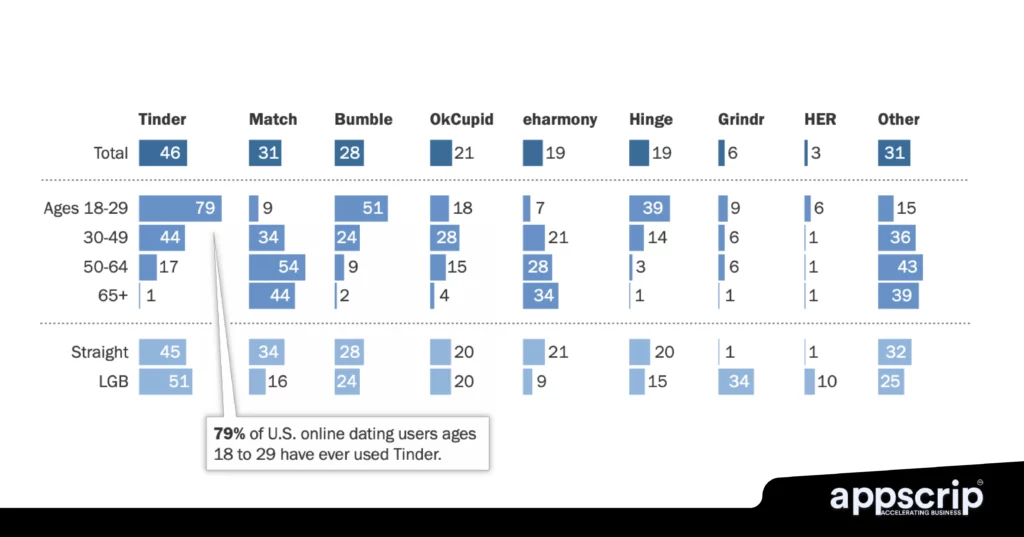
The users on various dating apps in the US region.
How to Monetize a Dating App
A dating app should be able to create amazing connections, but for it to continue operating profitably, there needs to be proven monetization models included in the solution. We shall detail the top one’s for you:
| Monetization Model | Description |
| Freemium Model | Offer basic features for free and charge for premium features (e.g., unlimited swipes, profile boosts). |
| Subscription Plans | Provide monthly, quarterly, or yearly subscriptions for access to advanced features. |
| In-App Purchases | Sell virtual gifts, stickers, or premium badges to users. |
| Advertisements | Display ads (banners, video ads) to free users. Offer ad-free experiences for premium users. |
| Affiliate Marketing | Partner with brands to promote products or services within the app. |
| Sponsored Profiles | Allow businesses or influencers to sponsor profiles for increased visibility. |
| Event Hosting | Charge for virtual or in-person dating events. |
| Partnerships | Collaborate with local businesses |
Frequently Asked Questions (FAQs)
1. How to Start a Dating App Without Experience?
Starting a dating app without experience is challenging but not impossible. Here’s how:
- Learn the Basics: Take online or offline courses to learn app development concepts.
- Hire Experts: You also have the option to partner with experienced developers, designers, and marketers to develop the app.
- Use No-Code Platforms: Platforms like Bubble or Adalo can help you build an app without coding knowledge.
- Start Small: Focus on a niche market (e.g., LGBTQ+, professionals, or hobbyists) where competition and complexity are low.
- Validate Your Idea: Conduct surveys or interviews to ensure there’s demand for your app.
2. How to Make a Dating App Stand Out in a Competitive Market?
To stand out, focus on unique value propositions (UVPs) and user experience:
- Niche Targeting: Cater to specific demographics (e.g., seniors, pet lovers, or music lovers).
- Innovative Features: Add innovative features like video profiles, AI-driven matchmaking, or gamified interactions.
- Superior UX/UI: Come up with clean, intuitive design for effortless navigation.
- Community Building: Build a sense of community via events, forums, or group activities.
- Strong Branding: Invest on creating a brand identity with a unique name, logo, and messaging.
3. How to Ensure User Safety and Privacy in a Dating App?
User safety and privacy are non-negotiable. Here’s how to ensure them:
- Profile Verification: Use email, phone, or social media verification to reduce fake profiles.
- Encryption: Encrypt user data and messages to protect against breaches.
- Reporting Tools: Allow users to report or block suspicious accounts easily.
- Privacy Settings: Let users control who can see their profile or contact them.
- Compliance: Follow data protection laws like GDPR or CCPA to avoid legal issues.
4. How to Integrate AI and Machine Learning in a Dating App?
AI and machine learning can enhance your app’s functionality:
- Matching Algorithms: Use AI to analyze user behavior, preferences, and interactions for better matches.
- Chatbots: Implement AI-driven chatbots for user support or icebreakers.
- Image Recognition: Use ML to detect inappropriate images or verify profile photos.
- Personalization: Offer personalized recommendations (e.g., date ideas or conversation starters).
- Fraud Detection: Use AI to identify and block suspicious accounts or activities.
5. How to Promote and Market a Newly Launched Dating App?
Effective marketing is key to gaining users:
- Social Media Campaigns: Use platforms like Instagram, TikTok, and Facebook to reach your target audience.
- Influencer Marketing: Partner with influencers to promote your app to their followers.
- App Store Optimization (ASO): Optimize your app’s title, description, and keywords for better visibility.
- Referral Programs: Encourage users to invite friends by offering rewards.
- Content Marketing: Create blogs, videos, or podcasts about dating tips to attract organic traffic.
6. How to Get Funding for a Dating App Startup?
Securing funding requires a solid plan and pitch:
- Bootstrapping: Start with personal savings or small loans to build an MVP.
- Angel Investors: Pitch to investors who specialize in tech startups.
- Venture Capital: Approach VC firms with a scalable business model and growth potential.
- Crowdfunding: Use platforms like Kickstarter or Indiegogo to raise funds from the public.
- Grants: Apply for startup grants or competitions focused on innovation.
7. What Are the Best No-Code Platforms for Building a Dating App?
No-code platforms are ideal for beginners:
- Bubble: Highly customizable with drag-and-drop functionality.
- Adalo: Great for creating mobile apps with pre-built templates.
- Glide: Turns spreadsheets into apps, perfect for simple dating apps.
- Thunkable: Focuses on mobile app development with easy integration of APIs.
- Appy Pie: User-friendly and affordable for basic app development.
These platforms allow you to build a functional app without coding, but customization options may be limited compared to traditional development.
Conclusion: Dating App Development
Entrepreneurs and developers looking to meet the growing needs of users will always find opportunities to come up with niche solutions in the dating app realm. By focusing on creating a unique, secure, and engaging platform, you can carve out your place in this industry.
Whether you’re just exploring how to build a dating app or you’re ready to dive into development, Appscrip has you covered. Our dating software solution offers a comprehensive, customisable dating software solution with which you can launch a successful dating app in the least possible time.
Want to know more. Get a demo.

